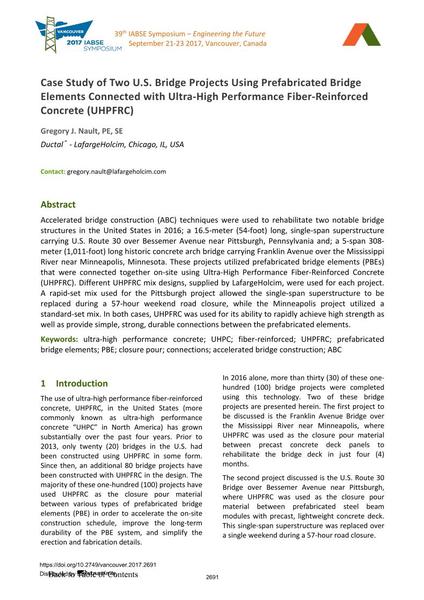Case Study of Two U.S. Bridge Projects Using Prefabricated Bridge Elements Connected with Ultra-High Performance Fiber-Reinforced Concrete (UHPFRC)

|
|
|||||||||||
Bibliografische Angaben
| Autor(en): |
Gregory J. Nault
(Ductal® - LafargeHolcim, Chicago, IL, USA)
|
||||
|---|---|---|---|---|---|
| Medium: | Tagungsbeitrag | ||||
| Sprache(n): | Englisch | ||||
| Tagung: | IABSE Symposium: Engineering the Future, Vancouver, Canada, 21-23 September 2017 | ||||
| Veröffentlicht in: | IABSE Symposium Vancouver 2017 | ||||
|
|||||
| Seite(n): | 2691-2698 | ||||
| Anzahl der Seiten (im PDF): | 8 | ||||
| Jahr: | 2017 | ||||
| DOI: | 10.2749/vancouver.2017.2691 | ||||
| Abstrakt: |
Accelerated bridge construction (ABC) techniques were used to rehabilitate two notable bridge structures in the United States in 2016; a 16.5-meter (54-foot) long, single-span superstructure carrying U.S. Route 30 over Bessemer Avenue near Pittsburgh, Pennsylvania and; a 5-span 308- meter (1,011-foot) long historic concrete arch bridge carrying Franklin Avenue over the Mississippi River near Minneapolis, Minnesota. These projects utilized prefabricated bridge elements (PBEs) that were connected together on-site using Ultra-High Performance Fiber-Reinforced Concrete (UHPFRC). Different UHPFRC mix designs, supplied by LafargeHolcim, were used for each project. A rapid-set mix used for the Pittsburgh project allowed the single-span superstructure to be replaced during a 57-hour weekend road closure, while the Minneapolis project utilized a standard-set mix. In both cases, UHPFRC was used for its ability to rapidly achieve high strength as well as provide simple, strong, durable connections between the prefabricated elements. |
||||
| Stichwörter: |
ultrahochfester Beton UHPFRC UHPC
|
||||
